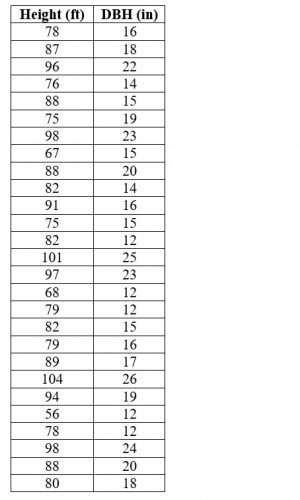NR 421 – Assignment #1
Refresher of Descriptive Statistics
Objective: This assignment will ask you to use quantitative approaches common to most disciplines of natural resource management. This should refresh the use of unit conversions and common descriptive statistics used in reporting populations.
Student Learning Outcomes: Upon completing this assignment you will:
- Be able to convert common English and metric units used in natural resources.
- Describe common statistical symbology.
- Apply basic descriptive statistics.
- Express your confidence in reporting a population parameter.
1. Convert the following measurements as specified:
- 24 inches to millimeters
- 18 square chains to acres
- 5,000 cu ft per acre to m3 per ha
- 24,000 kg per ha to grams per m2
- 200 lbs per ac to kg per ha
- 68 ha to acres
- 4.8 km to ft
- 0.1 acres to hectares
- 563 m3 per ha to cubic feet per acre
- 23 square miles to km2
2. Define the following statistical symbols:

3. Calculate the mean, median, mode, range, and standard deviation of the tree heights and DBH collected from a 1/10th acre monitoring plot on the Manitou Experimental Forest. Create histrograms for both datasets and describe their distributions, you can do this by hand or using your software of preference.

4. Calculate the Coefficient of Variation for both the DBH and Height data in question #3.
5. Write statements of our confidence for both the Height and DBH data in question #3 to a 95% confidence level using units. Use a t-value to at least three decimal places. See the Statistics Demystified.xls file on Canvas for an example.
6. What are the three requirements of any sample design?
7. Why are strip or rectangular plots oriented across slope?
8. How can we reduce our standard error of the mean?
Extra Credit (6 points):
Explain in your own words what the author of the Statistics fore Practicle People article has to say about the following ideas:
- What do the authors say is the most important thing in capturing a “representative” sample? And why do they say this is?
- What do the authors describe as a benefit and drawback of using random sampling?
- What is the overall message the author is trying to convey about sampling?
